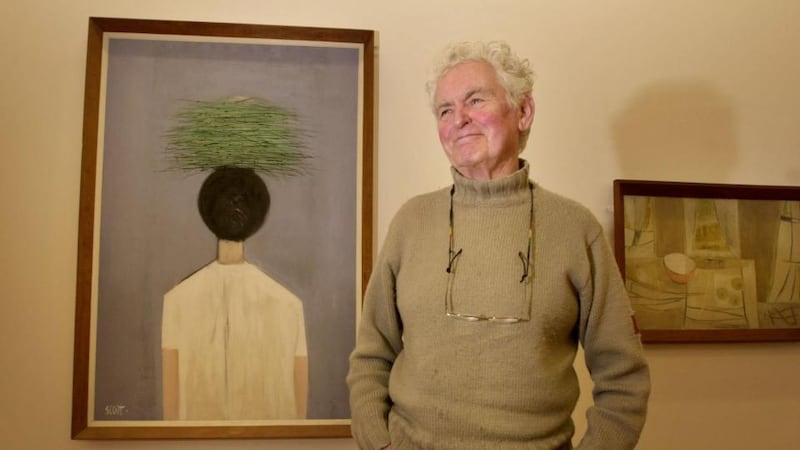In 1958 the architect, designer and painter Patrick Scott was on holiday near La Spezia, in Italy. He was mesmerised by the sight of a local woman carrying a bundle of grasses on her head at a time when such practices had all but disappeared across a rapidly modernising Europe. Travel abroad from Ireland was limited then, so exposure to such an exotic sight was a rare experience for a young artist. Although he felt uncomfortable witnessing the hard work involved, there was also something about the simple logic of physical balance and harmony that struck a chord. Scott was not the first modernist artist to find inspiration in local traditions and ancient practices, but his response was an unexpected departure in an Irish context.
Scott's experience translated into a series of paintings of which two in particular were soon to bring him to media attention in rather diverse ways. Scott was one of five artists selected to represent Ireland that year at the Guggenheim International Award exhibition, in New York, and, remarkably, one of his paintings, Woman Carrying Grasses, was purchased by the Museum of Modern Art there. This was the first painting by a living Irish artist to be purchased for MoMA, and the media was quick to report this significant achievement for Irish visual culture.
Another work from the series, a larger painting with a rich blue background and the similar title of Girl Carrying Grasses, featured at the Irish Exhibition of Living Art that summer, and it too caught the eye of a museum curator – although with a different result.

The MoMA painting was an audacious work, with its refined elegance, but far more challenging was the larger painting, which showed Scott approaching the abstraction he was soon to pioneer as he sought out the geometric equilibrium of the forms.
He departed radically from the charming genre that the title might suggest, with a solid half-length body topped by the dark disc of the head, on which balances a fragile interlace of straw, all in a decidedly untraditional, highly symmetrical composition. This was a bold statement in 1950s Ireland, but one whose value was recognized by Anne Crookshank, then keeper at Belfast Museum & Art Gallery (now Ulster Museum) and later founding professor of the department of the history of art at Trinity College Dublin.
Her role in Belfast was to recommend artworks for acquisition, and she astutely proposed the purchase of Scott’s painting, which carried a price tag of £105. She explained her reasons for recommending the work to Belfast Corporation, stressing both its originality and its classicism. To no avail. Alderman Tommy Henderson was unconvinced of its artistic merit. The media reported his description of the artwork as “appalling”, a “monstrosity” that would “be robbing the ratepayers”.
The opportunity passed for the gallery, but the work did not disappear from view. Two years later Scott represented Ireland at the Venice Biennale, described in the media as "the biggest exhibition in the world", with a solo show of 18 works that included both Girl Carrying Grasses and Woman Carrying Grasses, on loan from MoMA, where it had been on public display. Scott also remained an influential figure in Irish public design: he designed the mosaics at the Busáras terminal in Dublin – the entry for 1948 in this series – as well as the black and orange livery for CIÉ trains.
Although Scott would continue to distil from the visible world, he departed from direct interpretation of the human figure to explore the abstract potential of nuclear explosion, before developing just a few years later the contemplative minimalist Gold paintings for which he is best known.
You can read more about this week's artwork in the Royal Irish Academy's Art and Architecture of Ireland; ria.ie







